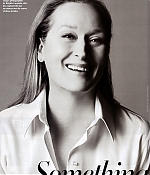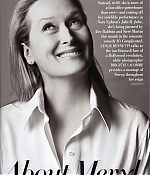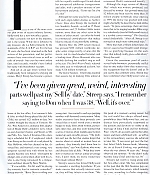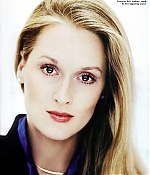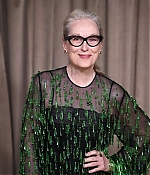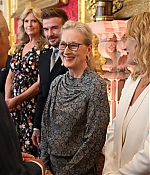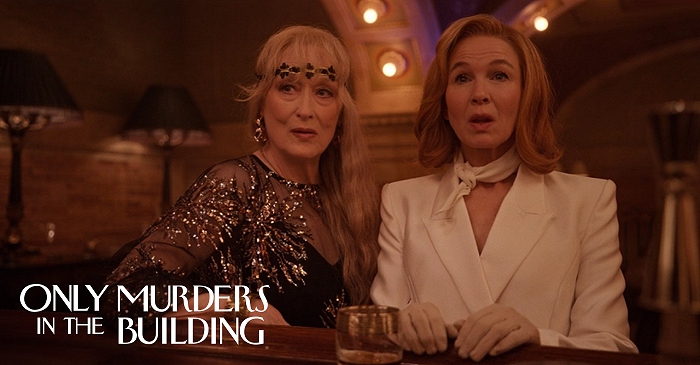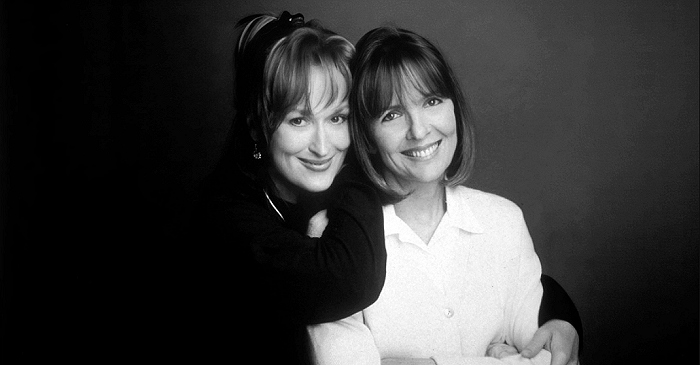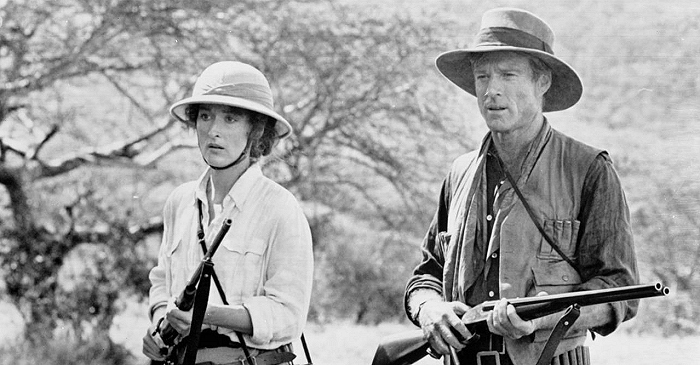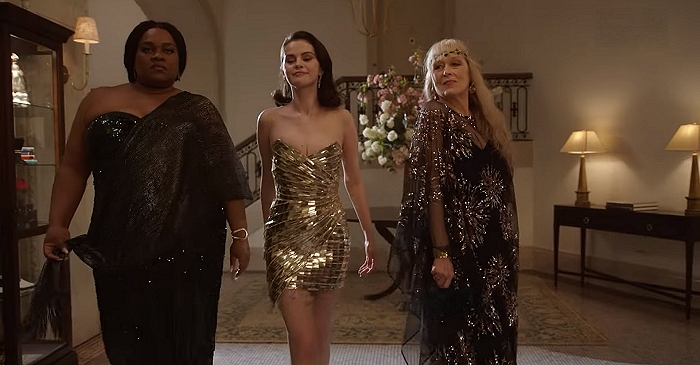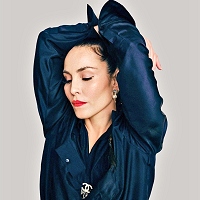|
Simply Streep is your premiere online resource on Meryl Streep's work on film, television and in the theatre - a career that has won her acclaim to be one of the world's greatest living actresses. Created in 1999, Simply Streep has built an extensive collection over the past 25 years to discover Miss Streep's body of work through thousands of photographs, articles and video clips. Enjoy your stay and check back soon.
|
|
Something About Meryl
Vanity Fair (US) ·
January 2010
· Written by Leslie Bennets
| ||
|
Tags
|
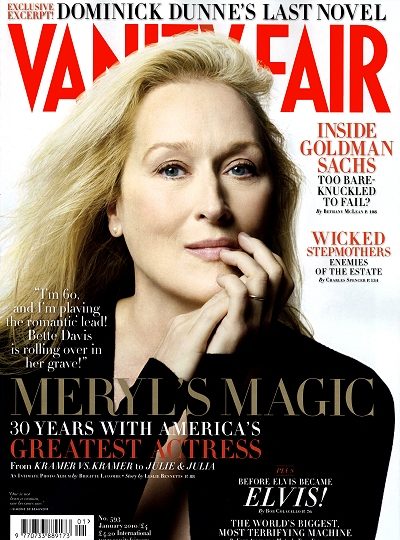
In one of the more curious plot twists of recent industry history, Hollywood has a new box-office queen.
She’s certainly not new to the industry, nor is she young. While she is fabulous by any measure, she is a babe primarily by the standards of the A.A.R.P. set. For the last 30 years, she has been venerated as the best actress of her generation, and her performances have won critical raves as well as rafts of awards—but even her most ardent fans, until recently, wouldn’t have linked her name with blockbuster receipts. And yet at an age when women have traditionally been relegated to playing old crones, Meryl Streep has become a powerhouse at the box office. Last summer’s Julie & Julia, in which Streep played the chef Julia Child, has earned $121 million to date. November brought the release of Fantastic Mr. Fox, Wes Anderson’s animated film adaptation of Roald Dahl’s children’s story, which co-stars George Clooney and Streep as Mr. and Mrs. Fox. And a Christmas Day opening is scheduled for It’s Complicated, which stars Streep as the ex-wife of a cad played by Alec Baldwin, who has cheated on her, divorced her, and married a very young, very gorgeous second wife with whom he has quickly become very bored—whereupon he plunges into a torrid illicit affair with his ex, who is also being romanced by a milquetoast architect played by Steve Martin.
“It’s incredible—I’m 60, and I’m playing the romantic lead in romantic comedies!” Streep marvels. “Bette Davis is rolling over in her grave. She was 42 when she did All About Eve, and she was 54 when she did What Ever Happened to Baby Jane?” Audiences have already pegged It’s Complicated, directed by Nancy Meyers, as a hit and Streep’s performance as a must-see, thanks to an irresistible trailer that elicits peals of laughter when Streep’s character tells her equally middle-aged friends about her unexpected adulterous transgressions and adds, with a priceless mixture of embarrassment and pride, “Turns out I’m a bit of a slut!”
Although her name used to be associated with such angst-ridden dramas as Sophie’s Choice, these days Streep, the recipient of two Academy Awards—as well as 15 Oscar nominations and 23 Golden Globe nominations, more than any other actor in the history of either award—can often be found in commercial crowd-pleasers that induce hilarity instead of uncontrollable sobbing. Mamma Mia!, the 2008 screen musical, has grossed $601 million worldwide, despite some cringe-worthy reviews (for the movie, not its much-lauded heroine) and a leading man (Pierce Brosnan) who was suitably dashing but couldn’t sing as well as he acts. The Devil Wears Prada, released the same year to widespread acclaim, has made $324 million worldwide.
The movie business—which long assumed that success lay in making films aimed at young men—has reacted to such eye-popping numbers with bemused consternation. Many studio executives have been privately convinced that it wasn’t worth even a modest budget to make films about women, particularly older ones, and they seem stunned that a series of movies about middle-aged women racked up such enviable grosses. “The problem isn’t just the fact that studios forget that movies about or aimed at women have an audience—they honestly don’t know how to market them,” says Nora Ephron, who wrote and directed Julie & Julia. “What they know how to market are movies aimed at teenage boys. I don’t think my movie would have been made without Meryl.” Streep’s success has forced Hollywood to consider a startling hypothesis: If you make movies that actually interest women, they will buy tickets to see them. “She broke the glass ceiling of an older woman being a big star—it has never, never happened before,” says Mike Nichols, who directed Streep in Silkwood, Heartburn, Postcards from the Edge, and HBO’s Angels in America. “Her crusade, at this point, is to show Hollywood how much money can be made from female-driven movies,” Entertainment Weekly commented recently.
Although the stage version of Mamma Mia!—which was written, produced, and directed by women—has grossed more than $2 billion and been seen by more than 30 million people worldwide since opening in 1999, the movie was greeted with what might charitably be described as faint enthusiasm. “In press screenings, there are murmurs that to be singing karaoke Abba songs in a relentlessly cheerful Hollywood musical is a terrible career misstep,” The Guardian noted disdainfully. “After all, Streep is renowned for much more substantial roles.” More than half a billion dollars later, the movie’s success has brought sweet revenge. “It’s so gratifying because it’s the audience that nobody really gives a shit about,” Streep has said.
Given the enormous pool of underserved baby-boomers, perennially miffed that no one makes films they want to see, the recognition that life doesn’t end at 30 just seems like common sense. Streep may have redefined what Hollywood views as the peak of a woman’s acting career, but the real world has always offered more possibilities than Hollywood has, and audiences have particularly responded to the passion and devotion so visible in the marriage of Julia Child and her husband, Paul—who by all accounts adored his taller, larger, and more celebrated wife—as well as to the extraordinary success she achieved in later life. “I can never get over the fact that Julia Child’s famous book, Mastering the Art of French Cooking, was published when she was almost 50 years old,” Streep observed last summer. “So she didn’t really become ‘Julia Child’ until she was 50.” Streep’s net worth is rising along with her box-office clout. She has complained in the past that the film business pays actresses far less than actors, which remains the case; according to Forbes magazine, Hollywood’s Top 10 actors earned more than twice as much as its Top 10 actresses between June 2008 and June 2009. With $24 million in earnings during that period, Streep ranked third among the women, slightly behind Angelina Jolie, who is 34, and Jennifer Aniston, who is 40.
Streep’s newfound power as a moneymaker isn’t the only surprise. In “An Evening with Meryl Streep,” at Toronto’s Royal Ontario Museum in October, film critic Johanna Schneller commented on what she saw as “something new” in Streep’s recent work, a quality the critic described as “a looseness, or what I would like to call a glee.” “Are you having more fun? Are you choosing projects that are more fun?” she asked.
Streep finessed the question by attributing her selection of roles to the increasing power of women in an industry heretofore dominated by the old boys’ club. “I really don’t get a choice; I don’t produce my own movies. So, I’m sort of like the girl at the dance who waits to be asked,” said the queen of Hollywood. “I don’t seek out material, I don’t buy books, I don’t curry favor with producers—I just wait. I think what you’re referring to is something that only happens now because there are more women in decision-making positions who are able to greenlight movies.” Streep’s exuberance is palpable in her performances. “The joy of working with her is that she truly thinks, ‘Oh, boy—I get to do this one more day!’ and working with her you certainly feel that,” says Nichols.
Audiences can see that Streep is having a devilishly good time, and her enthusiasm is contagious. “When I saw Julie & Julia, I just laughed and laughed and laughed,” says the French photographer Brigitte Lacombe, who has photographed Streep regularly for more than three decades, amassing a formidable collection of portraits that are sampled on these pages. “It was a great performance of her playing an enchanting character, but it was also the joy she was having doing it. It was exhilarating to watch. And the same year, she was doing Doubt, with this anger and this bitterness and all she was able to do with that.” Though Cherry Jones earned rhapsodic reviews with her portrayal of Doubt’s implacable Sister Aloysius on Broadway, John Patrick Shanley, who wrote the play and the screenplay and directed the film version, says that casting Streep in the movie was “kind of a no-brainer. If I had asked 20 people on the subway who should play the part, they all would have said, ‘Meryl Streep.’” Working with her lived up to every expectation. “She’s rigorous, stringent, and challenging in her thinking,” Shanley says. “She’s completely open to free association, but she has an analytical mind that is coupled with an enormous imagination, which is unusual. Meryl is spacious in her imagination and yet clinical in her approach to the material. She asks questions—of herself, of the character, of the scene, of the director—and she doesn’t assume she knows the answer. She’s looking around for something, and it’s not about her; it’s not about power or the clash of egos. It’s about the clash of ideas, which is a more fun piece of territory.
“On one level she is just like a big, mischievous cat—like a cat who sits in the corner and watches everyone and her tail twitches. She’s going inward and assessing outward. She’s a very interesting person to be around.” Streep’s meticulousness is legendary; Nichols remembers her going so far as to have fake dandruff applied to her shoulders when she played an elderly rabbi in Angels in America. Having directed Streep in Julie & Julia, Ephron says, “I would love to take credit for that amazing performance, but the truth is that she had read everything about Julia Child, she played the cooking tapes over and over between set-ups, she worked for weeks with Ann Roth to find the character through the costumes, and she even suggested that I cast Stanley Tucci as her husband.” Streep’s range has dazzled observers ever since the 1970s, when the Yale Drama School graduate began performing major Shakespearean roles with the New York Shakespeare Festival while also making movies. Lacombe first met Streep back then, and the photographer instantly recognized that the aspiring actress with the odd Dutch name was far more than the latest blonde ingénue. “The minute people set an eye on her, whether they were seeing her onstage or in the movies, they knew she was someone,” says Lacombe. “She was obviously different.”
After visiting the set of Kramer vs. Kramer, Lacombe shot the movie poster of Dustin Hoffman, Streep, and Justin Henry, who played the son buffeted by their divorce. Streep’s performance as the estranged wife who relinquishes her child to his father’s custody earned her the Academy Award for best supporting actress in 1979, and Hoffman won best actor; the film was named best picture. Three years later, Streep won the Oscar for best actress for her harrowing portrayal of a Polish concentration-camp survivor tormented by the loss of her children in Sophie’s Choice. Since then, nobody has doubted Streep’s ability to play anguish, but her talents as a comedienne were slower to gain recognition, even though her sense of humor is one of her most visible traits in person, continually bubbling to the surface like an irrepressible underground spring. Her first comedic film role didn’t come until 1989, when she co-starred with Roseanne Barr in She-Devil. “Surprise! Inside the Greer Garson roles Streep usually plays, a vixenish Carole Lombard is screaming to be cut loose,” reported Time magazine. Streep’s ability to mine the humor in unlikely places stuns even veterans like Mike Nichols. “It was always in her work,” he says. “When we did Angels in America, I said to her, ‘How in God’s name did you ever think of making Ethel Rosenberg funny?’ She said—and I think this is key—‘You never know what you’re going to do until you do it.’ You tap all your unconsciousnesses. In The French Lieutenant’s Woman, when she and Jeremy Irons are finally back together again, he says, ‘How could you run out on what we had?’ and he throws her to the floor. Her head hits the floor—and she giggles. Because it’s like Tarzan and Jane? Because she knows they’re all right now? That was one of the most miraculous acting moments I’ve ever seen, but the punch line is that they did six takes and she only did that once. To be able to tap your inner responses and know that’s the deepest part of the character is to be a great film actress.”
Streep has always interspersed her films with stage roles that ranged from Brecht to Chekhov, working steadily even as she and her husband, Don Gummer—a sculptor known for his large-scale, outdoor installations—raised four children. Henry, who is 30, is an actor and musician who uses the name Henry Wolfe. At 26, Mamie is an actress who recently announced her engagement to actor Ben Walker; her work has included Taking Woodstock and HBO’s John Adams. Grace, 23, made her Off Off Broadway debut in 2008 in The Sexual Neuroses of Our Parents, and Louisa, 18, graduated from high school last spring. As the last of her children leaves the nest, Nichols sees this stage of Streep’s life as another reason for her evident sense of well-being. “I think she’s very happy,” he says. “Anybody raising four children has worries, but they turned out so great, and you begin to relax a little bit. I think you’re seeing her freedom and her strength and her relief, to have brought four kids all the way through into hot careers of their own and happy love relationships. You still have them invisibly connected to you, but she’s free. At last you’re not thinking, ‘I have to run home,’ and things happen out of that freedom that are, if not new, deeper.” Streep has consistently guarded both her family’s privacy and her own, avoiding as much of the red-carpet hoopla and self-exposure in the service of publicity as she could get away with. Throughout Streep’s career observers have noted, as the film critic Molly Haskell wrote in 1988, “her determination to be an actress rather than a star in the old-fashioned sense, and to do idiosyncratic, theatrical roles in a medium in which success depends on being loved by huge numbers of people. In her willingness to forgo easy identification, Streep brings to dramatic point something that has been nosing its way to the forefront of consciousness for some time: the whole issue of a woman’s lovability.… No one has more steadfastly refused to look like a dish or ask for audience identification than Meryl Streep.… The determination to be different—each role not only different from the other, but different from what we assume Meryl Streep … to be—is the one constant in her career. An anti-star mystique seems to govern her life and her roles, a convergence, perhaps, of her seriousness as a performer and the inhibitions of a well-bred Protestant.”
Any inhibitions notwithstanding, a vibrant sexuality has remained a crucial aspect of Streep’s appeal, despite her advancing years and the limitations that others might try to impose in response. When Clint Eastwood cast her to star opposite him in The Bridges of Madison County, which won Streep an Oscar nomination for best actress, in 1996, his reason was simple: “She’s the greatest actress in the world,” he said with a shrug. That said, Streep reports, “There was a big fight over how I was too old to play the part, even though Clint was nearly 20 years older than me. The part was for a 45-year-old woman, and Clint said, ‘This is a 45-year-old woman.’”
When casting female roles, directors and producers have often applied a comically exaggerated double standard about age. With Streep now playing the ex-wife and current love interest of Alec Baldwin, who is actually nine years younger than she is, many observers have started wondering whether such old-fashioned biases are really changing in ways that will affect other actresses, or only in relation to Streep, who has always been sui generis. In any case, a good part of her aforementioned glee may have to do with her ongoing amazement that, after all these years, she’s still getting away with doing what she loves. “I’ve been given great, weird, interesting parts well past my ‘Sell by’ date,” she says. “I remember saying to Don when I was 38, ‘Well, it’s over.’ And then we kicked the can down the road a little further.” She’s still kicking it, but the sense lingers that there is something different about the way she has approached her career of late. At the program in Toronto, she finally described the critical shift in her attitude, both toward her work and toward herself. In her 20s, Streep was often criticized for not being a conventional beauty. “I have a really long nose,” she said merrily at the Royal Ontario Museum. One famous story has Streep auditioning for the part of the damsel in distress that was eventually won by Jessica Lange in Dino De Laurentiis’s 1976 remake of King Kong. Streep’s audition failed to impress the producer, who commented to his son, in Italian, “Why did you send me this pig? This woman is so ugly! Blech!” Having assumed that she wouldn’t understand what he said, De Laurentiis was shocked when Streep replied, in fluent Italian, “I’m very sorry that I disappoint you.” (De Laurentiis has denied this exchange occurred.)
Such insults were painful, but maturity and experience have freed Streep from wasting her energy on suffering over them. “So much of a young girl’s life—of my life—was taken up with worrying if I was attractive enough, or appealing enough,” she said in Toronto. “After a while, I got sort of tired of worrying about it. And also,” she added mischievously, “I was never pretty enough.” In her recent performances, one gets the impression that Streep has finally said to herself, “Oh, the hell with it.” And that feeling of personal liberation is exciting to watch. As the mother of three girls, she knows all too well how much pressure females feel to dim their light. “As girls grow up,” Streep observes, “as soon as boys come into the picture, you figure out that you have to modify that assertiveness thing in order to even be acceptable, let alone appealing, within the cohort of girls as well as boys.”
She has found it an enormous relief to outgrow those constraints. “I can’t remember the last time I really worried about being appealing,” she says with a snort of laughter. “I think it was a really long time ago. It’s freeing as an actress, but whether a director likes it or not is a different thing. I remember [director and co-star] Albert Brooks saying to me in Defending Your Life, ‘Could you just make it a little sweeter?’—and that’s been repeated by other people in the years since then.” This time her derisive snort is much louder. “But I don’t listen to it.” So how did she free herself? “I don’t think it’s something anyone can tell you,” Streep says. “I think you just have to get sick of hearing the accommodation in your approach to things … the way people have to get sick of drinking or drugs before they stop. As there begins to be less time ahead of you, you want to be exactly who you are, without making it easier for everyone else. I’m not sure I ever was really comfortable swanning around as a girl, anyway.” Given how striking she was and is, it’s still difficult for others to believe that Streep could ever have agonized about her looks. “I did not realize she was thinking she wasn’t beautiful enough, because to me she was so beautiful,” Lacombe says. “But she was not a regular beauty; she looked different. She had some things that set her apart. That was true then, and it’s true now. There’s that quote from Mike Nichols—he said, ‘She looks like she swallowed a lightbulb.’ There’s something that’s completely transparent about her, a glowing quality that’s quite striking and delicate. She’s so fine-looking, with very fine features.”
But, for the photographer, as for a director or an audience, Streep’s real power emanates from a deeper level. “She has a desire to play, and she’s always ready to jump in,” Lacombe observes. “There’s a sense of great joy and being in the moment. She’s someone who is not afraid of anything, and she is not afraid of being ridiculous. She does not watch herself, in the sense of actors who try to present a certain image when they’re not in character.” Streep’s famous transparency allows audiences to witness everything, just as it does with the camera. “There are quick changes of mood—extraordinary, like quicksilver—and you can see them on her skin,” Lacombe says. “When someone has a strong emotion or is about to cry, when the skin becomes blotchy and red and the eyes swell up—I’ve seen that happening with Meryl in such a subtle way. There is the ability to be in emotional places, and I think that’s why she is the actress she is.”
Although Streep’s acting is inextricably connected with the way she looks, she has always struck Lacombe as being virtually unique among performers. “I think there is a big absence of vanity in Meryl,” Lacombe says. “In A Cry in the Dark, she portrayed a character who was quite unsympathetic, but you never got the sense that she was trying to put you on her side, as some actors do. That’s another great, endearing quality of hers—I’m sure women sense that Meryl does not have any vanity. She never acted as a woman who was entitled. You know how some beautiful women just act beautiful? There is never any of that with Meryl—never. “With others, they are hypnotized by their own image, especially fashion people; they get completely enraptured. How many shots can you see of the same actress looking beautiful in every magazine? It’s like falling into a false sense of beauty and being worshipped for all the wrong reasons. They all do it. A lot of it is huge insecurity. Many actresses won’t wear their hair in a certain way, because it’s not the most flattering, or they won’t be photographed from a certain angle. But once someone like Meryl chooses a part, she does what is good for the character. She doesn’t bring her own insecurities and fears.” As she ages, Streep’s work derives additional power from her refusal to alter her face with cosmetic surgery or Botox. “If you start to do something like that, it’s very hard to stop,” Lacombe says. “If you understand that what makes your work good is not the way you look, as you grow older you take different parts. It’s like women in real life who want to hang on to a certain part of their life, and to look younger. They miss every other stage of their life. To try to stop the time, to look young—it’s such a futile, absurd way to look at life in general, and it’s very detrimental to their work. They may think that it prolongs their work, and maybe they might get one or two parts more, but their face is their tool, and also what they understand about life, what they go through in life. If you alter it, you deprive yourself of some of what you need to do your work well.”
Streep’s disdain for such desperate measures is based on her assessment of the toll they take. “When I see it in people I meet, it’s like an interruption in communication with them,” she says. “It’s like a flag in front of the view, and that, for an actor, is like wearing a veil—it’s not a good thing.” This attitude has long made Streep the perfect photographic subject for Lacombe. “I’m so anti all the artifice,” Lacombe says. “What I do is very simple; I’m not interested in transforming people.”
She gestures to the enormous coffee-table book of her work, Lacombe, which was published in 2008 and contains several riveting pictures of Streep. “To me, that’s Meryl, not an actress,” Lacombe says. “But it’s very rare. Even actresses in their 20s and 30s cannot look at themselves that way. They all long to be looking like a model—and then they wonder, Why am I not Meryl Streep? To me, physical beauty is not enough; it’s not interesting. Beauty is everything. You want to have someone who will also be funny, who will also be moving, who will also be intelligent—someone who will have some contribution to bring, not just a look. Meryl is interesting; she is very funny and very smart. “But I don’t think there is ever a moment when she is enjoying the process of being photographed. Most actresses, or women, will find a moment where they enjoy being looked at, if it is in the best light and with good intent. I don’t think Meryl has that moment—ever. She’s not interested in looking more beautiful or making more time so we can do better. I understand not wanting to be in front of the camera; for somebody very well known, it’s a complete bore and an imposition. I’m sure she sees that as Being Meryl Streep, and it’s not such an interesting part to play for her. She has a lot of patience and enjoyment if she is in character, but not if she’s herself.”
Streep’s explanation is simpler: “I hate to have my picture taken!” she exclaims. Looking over Lacombe’s photographs, which reveal Streep in a compelling array of moods and stages, another observer might remark upon her enduring beauty, her chameleon-esque ability to transform herself, or the remarkable range of her roles. But what she herself sees is very different. “I can really see when I’m pregnant,” she muses. “You see the little squirrel cheeks and stuff. In the 1986 picture, I’m pregnant with Grace; my hands are on my face because I’m holding the squirrels in—holding them back!” Another hoot of laughter.
The 2002 portrait, which Lacombe took after Streep’s makeup had been scrubbed off at the end of a shoot, was so unadorned that Streep’s publicist was horrified to learn that the American Film Institute was using it on a Sunset Boulevard billboard to advertise its tribute to Streep. “But she loved it,” the publicist says. “It’s my favorite one because they scraped all the crap off my face,” Streep says, snickering. “I’m looking at Brigitte after all these years—we confront each other through the lens, and she does get it: ‘Take the picture! Get it done so I can go home!’” And now Streep is tired of talking about herself, so it’s time to sum up how she feels about this stage in her life. “I’m very fucking grateful to be alive,” she says fervently. “I have so many friends who are sick or gone, and I’m here. Are you kidding? No complaints!”


Posted on October 14th, 2025
|
Posted on October 11th, 2025
|
Posted on September 30th, 2025
|
Posted on September 16th, 2025
|
Posted on September 9th, 2025
|




